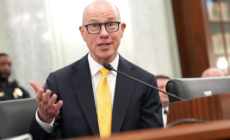-
Kyffin Simpson takes Will Buxton around Laguna Seca before Grand Prix of Monterey - 16 mins ago
-
Emotional Kimi Antonelli Opens Up About Confidence Struggles At Belgian GP - 21 mins ago
-
Jessica Alba shows off bikini body in Mexico months after divorce - 23 mins ago
-
AI-generated band earns thousands on Spotify with no human musicians involved - 50 mins ago
-
FAA to Modernize 40-Year-Old System After Fatal Washington DC Crash - 59 mins ago
-
Aaron Judge Scratched From Yankees Lineup, Sent For Imaging Of His Right Elbow - about 1 hour ago
-
How to Watch Supertri Toronto 2025: Live Stream Triathlon, TV Channel - 2 hours ago
-
Nick Kurtz Hits 4 Home Runs: Athletics’ Rookie’s Historic Night By The Numbers - 2 hours ago
-
Trump Says Thailand, Cambodia Support Ceasefire Push - 2 hours ago
-
Fox News Entertainment Newsletter: Ozzy Osbourne dead at 76, Kevin Sorbo sees Hollywood dramatically shift - 2 hours ago
Fast-food isn’t so affordable anymore. Here are the U.S. cities where prices are the highest.
Like Subway’s $5 footlong, affordable fast-food may soon be a thing of the past.
The average price of fast-food in larger U.S. cities is now in the double digits, with the typical meal costing $11.56, according to a new report from LendingTree. Prices are highest in San Francisco, where the average fast-food meal costs $13.88, followed by Seattle at $13.48. Columbus, Ohio, has the most affordable fast-food, but meals still came to $10.01 on average.
Fast-food has long been considered a more economical, if not more healthful, way to eat. Whether it’s Wendy’s “Biggie Bag” or McDonald’s “McValue” menu, most major fast-food chains offer some sort of meal deal for under $10. But as costs rise and inflation pinches Americans’ wallets, the cost of burgers, fries and chicken nuggets may be slipping out of reach for many consumers.
A FinanceBuzz analysis found last year that average fast food prices have risen between 39% and 100% over the last decade. For example, a McDouble sandwich that cost $1.19 in 2014 would easily cost more than $3 in 2024, the personal finance site found.
Thirty-nine percent of Americans expect to spend less on dining given heightened uncertainty about the economy, according to a recent Bankrate survey.
According to McDonald’s most recent earnings report, the company experienced a 3.6% drop in sales the first quarter, with executives citing tariffs as the reason behind the slower foot traffic.
“Heightened anxiety” about the economy is weighing on lower- and middle-income Americans, McDonald’s CEO Chris Kempczinski said in a May 1 earnings call.
Among the consumers who may be struggling with the cost of fast-food — the low-income employees who make it. The average hourly wage for fast-food workers is $15.07, according to LendingTree. That means it takes workers more than two times longer than someone on an average wage in the U.S. to earn enough to afford a typical fast food meal, while factoring in the cost of other living expenses.
“No one has ever expected to get rich off of fast-food wages, but the fact that these workers can’t even expect a livable wage is troubling,” LendingTree chief consumer finance analyst Matt Schulz said in the report.
LendingTree found that a fast-food worker who purchased three meals a day from their employer, seven days a week, would end up spending 40% of their salary on average — leaving them with just 60% of their paycheck to live on.
Source link































